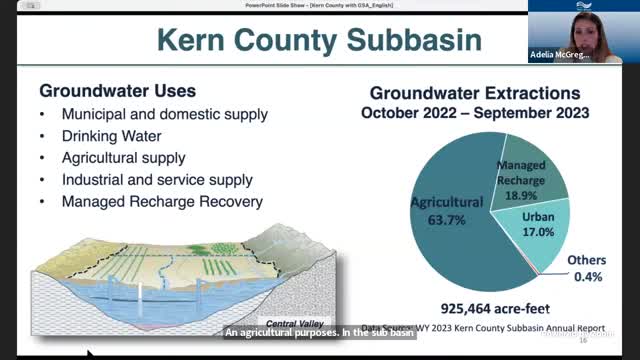Groundwater crisis deepens as wells run dry in Kern County
August 26, 2024 | State Water Resources Control Board, Agencies under Office of the Governor, Executive, California
This article was created by AI summarizing key points discussed. AI makes mistakes, so for full details and context, please refer to the video of the full meeting. Please report any errors so we can fix them. Report an error »

In a recent government meeting, officials discussed critical groundwater issues affecting the Kern County subbasin, highlighting alarming trends in water extraction and its consequences. During the water year 2023, approximately 925,500 acre-feet of groundwater were extracted, equivalent to about 500,000 Olympic-sized swimming pools. The agricultural sector accounted for 64% of this usage, while urban areas utilized 17%, and managed recharge efforts made up 19%. Only 0.5% was categorized under other uses.
The meeting revealed that groundwater pumping in the Kern County subbasin has consistently outpaced natural and human-assisted recharge, leading to a significant decline in groundwater levels over the past decades. This depletion has forced residents to deepen existing wells or drill new ones to access deeper water sources. A recent analysis conducted by the Department of Water Resources indicated that approximately 227 domestic wells are at risk of running dry in future droughts, with ten wells already reported dry in the current water year.
Additionally, over-extraction of groundwater has resulted in land subsidence, particularly in areas underlain by fine-grain sediments. As groundwater is removed, these sediments compact, causing the land surface to lower, which can permanently reduce the groundwater storage capacity and negatively impact critical infrastructure such as canals and levees. Satellite data from June 2015 to January 2024 showed significant subsidence in the region, with the Friant Kern Canal and California Aqueduct experiencing notable elevation drops.
The meeting also addressed the potential degradation of groundwater quality due to declining water levels. As groundwater levels fall, concentrations of contaminants like nitrate have been observed to rise in shallow wells, posing risks to domestic drinking water supplies. The state water board is actively assessing these risks and implementing measures under the Sustainable Groundwater Management Act to address the challenges facing the Kern County subbasin.
Officials emphasized the urgency of these issues, as they not only threaten water availability but also the quality of drinking water for thousands of residents and the agricultural viability of over a million acres of farmland. The discussions underscored the need for coordinated efforts to manage groundwater sustainably and mitigate the impacts of ongoing drought conditions.
The meeting revealed that groundwater pumping in the Kern County subbasin has consistently outpaced natural and human-assisted recharge, leading to a significant decline in groundwater levels over the past decades. This depletion has forced residents to deepen existing wells or drill new ones to access deeper water sources. A recent analysis conducted by the Department of Water Resources indicated that approximately 227 domestic wells are at risk of running dry in future droughts, with ten wells already reported dry in the current water year.
Additionally, over-extraction of groundwater has resulted in land subsidence, particularly in areas underlain by fine-grain sediments. As groundwater is removed, these sediments compact, causing the land surface to lower, which can permanently reduce the groundwater storage capacity and negatively impact critical infrastructure such as canals and levees. Satellite data from June 2015 to January 2024 showed significant subsidence in the region, with the Friant Kern Canal and California Aqueduct experiencing notable elevation drops.
The meeting also addressed the potential degradation of groundwater quality due to declining water levels. As groundwater levels fall, concentrations of contaminants like nitrate have been observed to rise in shallow wells, posing risks to domestic drinking water supplies. The state water board is actively assessing these risks and implementing measures under the Sustainable Groundwater Management Act to address the challenges facing the Kern County subbasin.
Officials emphasized the urgency of these issues, as they not only threaten water availability but also the quality of drinking water for thousands of residents and the agricultural viability of over a million acres of farmland. The discussions underscored the need for coordinated efforts to manage groundwater sustainably and mitigate the impacts of ongoing drought conditions.
View full meeting
This article is based on a recent meeting—watch the full video and explore the complete transcript for deeper insights into the discussion.
View full meeting
